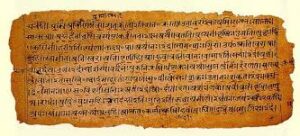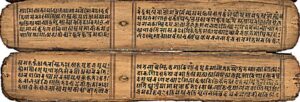A language is a system of communication, and a classical language is its modification with distinct literary traditions and a substantial body of ancient written literature. In this blog, we will try to discover some amazing facts with regard to the origin and history of the Sanskrit language.
Sanskrit, an ancient Indo-European language, is a classical language language used to compose some of the most precious and important manuscripts of ancient Bharat. The word Sanskrit is believed to be derived from the linguistic term ‘Samskrta,’ which resembles the words ‘accomplished, perfect’.
Join me on this journey, where we will walk along the timeline of the Sanskrit language and understand its importance in Indian history.
From its ancient roots to its lasting influence, this exploration will shed light on how Sanskrit shaped the cultural and historical landscape of India.
The Vedic Sanskrit

The origin of the early Sanskrit language is something very complex and has been a subject of scholarly debates. However, the earliest evident proves that the early seeds of the language were sown in South Asia, a language that is believed to be older than the Vedas itself, a language in which the World’s first book, the Rig Veda, was composed. The four Vedas in Hinduism has been dated around 6500 B.C. to 1500 B.C. by different scholars.
However, the language used to compose these Vedas was in the form of a different dialect. The language was somewhat different from the present Sanskrit and was termed Vedic Sanskrit.
The Classical Sanskrit

While many of the Sanskrit mantras that we hear today are in Vedic Sanskrit, some mantras are also composed in Classical Sanskrit, which is a later, more refined form of the language. Classical Sanskrit (the present-day Sanskrit) started to emerge in the mid-1st millennium BCE.
Around 500 BCE, the grammarian Pāṇini played a crucial role in developing classical Sanskrit. The Vedic language was standardized. Pāṇini’s work, the Astadhyayi, is a comprehensive grammar of Sanskrit that brought in the transition of the language from Vedic to classical.
The shift in the language brought in a cultural shift as the classical Sanskrit became a wider medium of presenting literary, scientific and philosophical works.
The Language and its Usage

A sacred language to Hinduism, Sanskrit became the medium of propagation for Hindu philosophy along with historical texts of Buddhism and Jainism. It became a link language in ancient and medieval South Asia, a language of religion and high culture, reserved for the elites, scholars, and royalties.
The Vedic Sanskrit is prominently found in the four Vedas, and the language, in olden times was preserved through oral transmission, long before it was written down. The Shruti, which means ‘that which is heard’, and the Smriti, which means ‘that which is remembered’ were a part of this old tradition. The oral transmission ensured the preservation and proper pronunciation and intonation of the texts.
Meanwhile, classical Sanskrit became the language of many prominent works of literature, including the Ramayana and Mahabharata. Other important texts like Upanishads, Puranas, and various other sutras were also composed in this language.
Sanskrit, a language not for the commoners!
Sanskrit was called the ‘Dev Vani,’ which means the language of Gods and was therefore limited to the Brahmans and elites of society. The common people, however, spoke various Prakrits and regional languages. These languages were the everyday, communicating language.
While Sanskrit means ‘refined’ or well-formed’, Prakrit was derived from the root word ‘Prakriti’ which means ‘nature’ or ‘natural’.
The various forms of Prakrit include Maharshtri, Magadhi, Shauraseni, Awadhi, etc.
The regional languages include languages of the Tibeto-Burman family in the Northeastern part of India, while Dravidian languages like Tamil, Telugu, Kannada, etc., in the Southern part of India.
Sanskrit in the Present

The present condition of Sanskrit is like any other historical monument being restored. Despite its importance being still alive amongst the Indians and their culture, the language isn’t widely spoken as a first language in the country.
The arrival of the Islamic and Western rules in India brought in a transition to the Prakrit language, simplifying it, hybridizing it and finally, the Hindi language came into existence. The hybridization marked the birth of both Hindi and Urdu. The Hindi language incorporated a huge vocabulary from Sanskrit in itself!
However, Sanskrit in its pure classical form isn’t widely spoken across India. Sanskrit is taught in many schools and universities across India and around the world. It also remains integral to Hindu rituals, ceremonies, and classical arts, including music and dance. There are daily newspapers, TV programs, and magazines in Sanskrit, a mere effort to keep this ancient language alive.
The government and universities also offer fully funded research programs related to Sanskrit for its promotion.
Mattur, a village in Karnataka, is the only Sanskrit-speaking village left in India. check out: The Last Sanskrit-speaking village: Mattur, Karnataka
CONCLUSION
Sanskrit, a language older than Latin and still alive, has served as a foundation for many languages. It is not a mere medium of propagation but a bridge to ancient wisdom. It is a living tradition that continues to inspire and educate. Its legacy is a reminder of the rich tapestry of human culture and the timeless quest for knowledge and understanding.
WANT TO KNOW MORE ABOUT INDIAN CULTURE AND TRADITION: The Journey of Meditation: its Origin and Timeline

